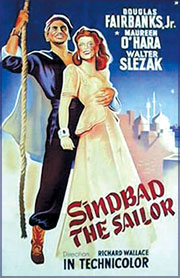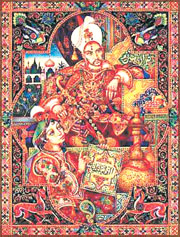|
DAILY NEWS ONLINE |
|
|
|
OTHER EDITIONS |
|
|
|
|
|
|
|
|
|
OTHER LINKS |
|
|
|
|
|
|
  |
|
Marvels and wonders of the Arabian Nights
|
|
|
Well, they were just some of the breathtaking tales from the Arabian Nights, which captivated the childhood imagination, wonderment and curiosity of many past generations in Sri Lanka and abroad.
Valour, action, adventure, excitement, horror, mystery, incredulity and romance were the distinctive features in the books and movies of the Arabian Nights, also known as the "One Thousand Nights and a Night", or Alf Layla wa-Layla in Arabic.
Generations of western-oriented children in the colonial area of Sri Lanka, became exposed to the Nights fantasy.
The tales were unique in those halcyon days, for they were set in exotic lands with romantic and out-landish events.
The Sinhalese translation of Arabian Nights was published under the title, "Arabi Nisollasaya", and it became extremely popular among the new generations of Sinhala-educated youth in Sri Lanka.
|
|
At St. Benedict's College boarding of the sizzling '50s, I had an irrepresible desire to read the few English books of Arabian Nights available at the college boarding library.
In an age without TV or DVD, I used to reread those books, because the stories therein were most absorbing, and beautifully illustrated to arrest the attention of youngsters.
When I finished reading the library books of the Arabian Nights, I went searching for other books of the same series, at secondhand book vendors in Maradana, where they used to lend books in return for a nominal fee.
My interest in the Arabian Nights grew considerably, when a genial, old French priest named Fr. Martin brought his movie projector to the college boarding once a week and entertained us, the half-starved, homesick boarders, with 16 m movies of Arabian Nights and cow boy adventures.
|
|
The full collection of the Arabian Nights (now available in one volume) is comprised of literally hundreds of stories, many contained within other stories, all dating back more than a thousand years.
The Arabian Nights are a collection of Persian, Arabian and Indian folk tales handed down through several centuries. There is no definitive text, but several variant manuscripts.
"Arabian Nights is one of the most valuable treasures of all literature. Over the centuries, hundreds of editions have appeared, based on many different translations and illustrated by some of the most famous illustrators in history. The stories of the Arabian Nights were written by many people over the course of hundreds of years.
The core of original stories came out of Persia and India in the early eighth century. They were translated into Arabic and given the name Alf Layla or The Thousand Nights. This set of stories was few in number and fell far short of living up to the number in its title.
In Iraq in the ninth or tenth century, a group of Arab stories were added. This new group probably contained the tales that refer to Caliph Harun al-Rashid. In the following years, several tales that had previously existed outside of the Nights, were incorporated into the main body of the tales.
At the beginning of the 13th century, another group of tales was added.
They were of Syrian or Egyptian origin. In "modern" times, additional tales were added (by Galland, for example), and the total was brought up to the number given in the title. Several early manuscripts of the Nights survive.
The oldest is a single page fragment that dates to the ninth century. The next oldest is a three-volume Syrian manuscript in the Paris Bibliotheque Nationale (MSS arabes 3609-11) that dates from the early 14th century.
Galland used this manuscript for his ground-braking translation in the early 1700s, which introduced the Nights to Europe (although he used other sources as well).
The exact origins of this manuscript are unknown. All of these texts that comprise the Arabian Nights, have been the basis for various translations in English and various other foreign languages.
The Arabian Nights stand hear the top of the list of literary works that have influenced Western literature. The real influence began, however, when Galland's translation brought the full set of the tales to Europe in the early 1700s.
Sir Walter Scott read the Nights as a child and they stayed with him for the rest of his life. Allusions to the Nights are peppered throughout Scott's novels.
As a child, Samual Taylor Coleridge absorbed the Nights. Charles Dickens was a great fan of the Nights.
His works are full of references to the places and characters of the Nights Robert Louis Stevenson pulled directly from the Arabian Nights in his New Arabian Nights (1882).
This work is a collection of short stories (loosely linked and somewhat framed by the structure of the book), set in London and Paris.
No modern author used the Nights more extensively than O. Henry (William Sydney Porter). O. Henry used the Nights as his own framework on which to hang his own stories.
The Arabian Nights stand out as one of the stellar achievements in literature.
Hundreds of people contributed to their form and substances over the hundreds of years of their development. The result has entertained and influence readers for generations.
Hundreds of people have illustrated the Arabian Nights over the centuries, making it one of the most profusely illustrated works of all time.
The writer is the author and publisher of "Alien Mysteries in Sri Lanka and Egypt, the new Version", which was launched recently. The book is available at leading bookshops.
|
|




